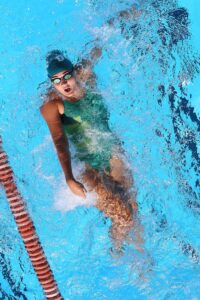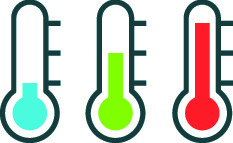Research with elite women’s wheelchair basketball athletes has shown playing time can negatively impact body temperature regulation, increasing the risk of heat exhaustion, heat cramps, and heat stroke. Coaches are encouraged to monitor the cooling strategies of athletes with high playing time and encourage all athletes to hydrate during time outs, substitutions, intermissions, and half time.
Many ultramarathon runners believe the consumption of sodium supplements during competition will prevent the symptoms of exercise-associated hyponatremia, including dehydration, muscle cramping, and nausea. However, accumulating evidence suggests supplementing sodium intake above what is consumed in food and drink is generally not necessary, and could be dangerous.
While hydration practices during training and competition are important, new research emphasizes the importance of beginning endurance exercise in a well-hydrated state. Athletes experiencing pre-exercise dehydration showed impaired aerobic exercise performance, peak oxygen consumption, and lactate threshold.
In American football, measurements revealed youth and college-level athletes experienced anywhere from 100-1,000 head impacts during the season. That trauma can add up, risking long-term impacts on brain health, including cognitive, emotional and behaviour difficulties and dysfunction. Consider the role of nutrition in protecting against repetitive sub-concussive injury.
Mary Cain, a former record-breaking phenom, made a different type of headline when she spoke up about the pressure she faced to lose weight that caused her to disappear from the running scene (Cain, 2019). Cain’s willingness to speak up started a social media movement that brought to the public’s attention the cost of under-fuelling to an athlete’s physical and mental health.
The evolution of relative energy deficiency in sport
While not realizing it at the time, Cain, who had lost her period, experienced five bone stress fractures, and whose performance was suffering, was experiencing relative energy deficiency in sport (RED-S). Introduced in 2014 by the International Olympic Committee (IOC) consensus group, RED-S is a syndrome that impairs various physiological functions, including metabolic rate, menstrual function, bone health, immunity, protein synthesis, and cardiovascular health (Mountjoy et al., 2014). The underlying cause of RED-S is low energy availability – this occurs when calorie intake is insufficient to meet the calories expended through exercise, leaving inadequate energy for normal bodily function (Loucks & Heath, 1994).
While the terminology of RED-S was not introduced until 2014, the negative impact of low energy availability on athlete health was not a new finding. Studies in the 1980’s demonstrated that amenorrhea – the absence of menses or irregular menstrual cycles – had implications not only for reproduction, but was also detrimental to bone health (Drinkwater et al., 1984, 1986). Building on this foundational research, the American College of Sports Medicine (ACSM) published a position statement on the “female athlete triad” in 1997 – an interrelated syndrome of disordered eating, absence of menses or irregular menstrual cycles, and poor bone health (Otis et al., 1997).
While the female athlete triad undoubtedly enhanced research on athlete health, accumulating evidence pointed to the fact that low energy availability had negative impacts beyond bone health and reproductive function, and that a state of low energy availability was also of concern to male athletes (Mountjoy et al., 2014). Notably, the 1997 female athlete triad ACSM position statement highlights that male athletes could be at risk of disordered eating and that this was associated with poor bone health and reductions in the male sex hormone testosterone (Otis et al., 1997). However, the terminology of the female athlete triad is not inclusive to both sexes, and males were largely excluded from research assessing the impact of low energy availability on athlete health. As such, the term RED-S was introduced to be more comprehensive and inclusive of both female and male athletes (Mountjoy et al., 2014). Since the 2014 consensus statement on RED-S, there has been much advancement on RED-S research, as well as an updated IOC consensus statement in 2018 (Mountjoy et al., 2018). This has ultimately served to increase awareness of RED-S and the serious health and peformance outcomes that can result.
Risk and prevalence

Athletes competing in sports with high rates of disordered eating are considered to be at a higher risk of developing RED-S. This includes athletes competing in aesthetically judged sports (figure skating, rhythmic and artistic gymnastics, synchronized swimming), body-weight dependent sports (long-distance running, mountain and bike cycling, ski jumping, jumping eventing in athletics), and weight class sports (lightweight rowing, judo, wrestling) (Sundgot-Borgen et al., 2013). However, RED-S is still a concern for athletes competing in other sports. For example, within sprinting (a sport not typically associated with RED-S), one study reported 39% of elite female athletes presented with indicators of RED-S (Sygo et al., 2018), which was comparable to the 44% of female ultra-endurance runners identified as at risk of RED–S in another study (Folscher et al., 2015). RED-S does not only occur from disordered eating or intentional reductions in calorie intake, but can also occur unintentionally. For example, an athlete who is unaware of their calorie needs, coupled with a reduced appetite from training, may develop RED-S unintentionally if the energy deficit is not addressed over the long-term (Douglas et al., 2017).
RED-S can occur in athletes of any competitive status. Among world class endurance athletes, 37% of females presented with amenorrhea and 40% of males with testosterone in the lowest quartile range indicative of RED-S (Heikura et al., 2018), which is similar to the reported 40% of Australian female athletes competing at the 2016 Rio Olympic games who were identified as at risk of RED-S (Drew et al., 2018). Similarly, among recreational female exercisers, 45% had risk factors associated with RED-S (Slater et al., 2016). To date there has been little research assessing RED-S prevalence among para-athletes; however, one study suggests a majority of para-athletes (62%) were trying to lose weight, and a number of indicators associated with RED-S were reported in this population (Brook et al., 2019). This included 44% reporting menstrual dysfunction and 55% with low bone mineral density (Brook et al., 2019). While the full prevalence of RED-S has yet to be uncovered, these studies demonstrate that RED-S may represent a hidden danger to athletes.
Health implications
The initial health outcomes of RED-S focused on amenorrhea and bone health (Drinkwater et al., 1984, 1986). In women, reduced bone health occurs not only from the low estrogen that occurs with amenorrhea, but also from poor calorie intake (De Souza et al., 2008; De Souza & Williams, 2005). Likewise, in male athletes, the reduced testosterone seen in situations of a calorie deficit has negative implications for bone health (Hooper et al., 2017; Smith & Rutherford, 1993). While young athletes may be unconcerned about the implications of reproductive dysfunction, this increases the risk of bone stress injury development during training and competition (Heikura et al., 2018), and in later years, can increase the risk of osteoporosis as peak bone mass is developed during adolescence and young adulthood (Baxter-Jones et al., 2011).
A notable change with the new terminology of RED-S (instead of female athlete triad) was that it expanded awareness of the health outcomes of low energy availability beyond reproductive function and bone health. Other health consequences include:
- Cardiovascular: While physical activity is generally considered to have positive implications on the cardiovascular system, athletes with RED-S may be predisposed to cardiovascular disease. Studies show female athletes with RED-S had impaired vascular function (Hoch et al., 2003; O’Donnell et al., 2014, 2007) and unfavourable lipid profiles (Ayres et al., 1998; Friday et al., 1993; Kaiserauer et al., 1988; Rickenlund et al., 2005).
- Metabolic: Athletes with RED-S often have a suppressed resting metabolic rate, which serves as an energy conservation mechanism (Koehler et al., 2016; Melin et al., 2015; Torstveit et al., 2018). This reduced resting metabolic rate explains why athletes with RED-S have a stable body weight despite being in a calorie deficit, as the body’s calorie requirements are decreased (Trexler et al., 2014).
- Hematological: RED-S has been implicated in increasing the risk of iron deficiency, which can be detrimental to exercise performance and recovery. Iron deficiency may occur directly from reduced dietary iron intake, or be caused by the release of hormones that reduce iron absorption (Badenhorst et al., 2019; Ishibashi et al., 2020).
- Psychological: Poor psychological health can contribute to the development of RED-S, but calorie restriction can also result in psychological consequences, such as major mood disturbances in athletes (Fagerberg, 2018). Higher levels of depression, excessive concerns about dieting and weight gain (Bomba et al., 2014, 2007), and a greater need for social approval (Strock et al., 2020) have all been reported in athletes with RED-S.
Performance implications

For many athletes, the development of RED-S is precipitated by changes to their diet to improve performance. But without the right balance between exercise intensity and caloric intake they negatively impacted their health and performance. Calorie restriction results in reduced muscle glycogen stores (Kojima et al., 2020) that may reduce an athlete’s tolerance of training and competition demands (Costill et al., 1988). In comparison to healthy counterparts, female athletes with RED-S have been shown to have impaired reaction time, knee muscle strength, and knee muscle endurance (Tornberg et al., 2017). Likewise, female swimmers with RED-S showed reductions in swim performance over a swim season, while healthy counterparts improved performance (Vanheest et al., 2014). Performance decreases may occur indirectly due the health consequences of RED-S such as iron deficiency or iron deficiency anemia (Sim et al., 2019), or by interfering with an athlete’s ability to consistently train and compete due to the increased risk of illness (Drew et al., 2018) and injury (Heikura et al., 2018; Logue et al., 2019).
The warning signs of RED-S
Given the negative health and performance outcomes associated with RED-S, early identification is vital. While low energy availability is the underlying cause of RED-S, calculating an athlete’s level of energy availability based on caloric intake and exercise energy expenditure is not recommended due to the considerable calculation error (Burke et al., 2018). There are screening tools available, such as the Low Energy Availability in Females Questionnaire (Melin et al., 2014) and the RED-S Clinical Assessment Tool (CAT), to assess an athlete’s risk of RED-S and guide return to play decisions (Mountjoy et al., 2015). While both are valuable, they are meant for use by researchers and trained medical professionals.
However, coaches, teammates, family, and friends are usually in the position to be the first to recognize early warning signs in athletes that warrant further investigation by a medical professional. These may include:
Physical changes:
- Missing or irregular periods in females
- Low sex drive and decline in morning erectile function in males
- Changes in weight or lack of expected growth and development in adolescent athletes
- Recurring injuries and illness
- Reduced body temperature and increased sensitivity to cold
- Gastrointestinal issues such as constipation or bloating
- Downy growth of hair on the body
Behavioural changes:
- Restrictive eating such as cutting out food groups, counting, measuring, or weighing foods
- Avoiding food-related social activities
- Secretive behaviour regarding food intake and/or exercise
- Pre-occupation with food, calories, body shape, and weight
- Additional training above what is required and/or difficulties taking rest days
- Disturbed sleep and sleeping difficulties
Psychological changes:
- Becoming withdrawn and reclusive
- Anxiety, irritability, and difficulties concentrating
- Increased attention and/or criticism of body
- Body image dissatisfaction and distortion
It is important to note that it should never be assumed that an athlete is well just because they appear to be a healthy weight, or even if they are overweight. Athletes may be in a calorie deficit despite having a stable body weight due to reductions in resting metabolic rate. RED-S can occur in athletes of any sport, across any age, body size, culture, socioeconomic status, and athletic ability. The development of guidelines, referral protocols and education for athletes, coaches, integrated support team members, and others could help support early identification of athletes at risk of or experiencing RED-S.
Treatment and recovery
Similar to their role in recognizing early warning signs of RED-S, coaches, teammates, family, and friends play a critical role in supporting struggling athletes to seek help from a trained professional. This is critical as early identification and treatment is important to prevent long-term health outcomes from RED-S. While addressing the underlying energy deficit is necessary in the treatment of RED-S, treatment usually involves a multi-disciplinary team of health care professionals to address the inter-related facets of this condition, including a sports medicine physician, registered dietitian, and psychologist (Mountjoy et al., 2015).

In the case of RED-S due to unintentional low energy availability, nutrition education from a registered dietitian may suffice (Mountjoy et al., 2018). However, when an athlete presents with disordered eating or a clinical eating disorder, ongoing medical, dietary, and mental health support will typically be required (Mountjoy et al., 2018). Early identification and appropriate management of disordered eating is especially important as this leads to better outcomes (Wells et al., 2020). The decision for continued sport participation in an athlete with RED-S will depend on the athlete’s clinical presentation. In some instances, an athlete may be allowed to train in a supervised setting with ongoing re-evaluation, but in other circumstances, participation in no activity will be recommended as continued training or competition may pose a serious jeopardy to athlete health (Mountjoy et al., 2015). Coaches and trainers should collaborate with the athlete and treatment team and adjust training load accordingly. Like the treatment strategies employed, the time for recovery will differ with each athlete, their unique situation and clinical presentation. Throughout the recovery and treatment process, coaches, teammates, family, and friends play an important role in providing support to the athlete.
How coaches and help prevent RED-S
Sport organizations and those involved in athlete care are in a unique situation to create a healthy sport culture that maintains athlete’s physical and mental health. Creating a healthy sport culture is critical for the prevention of RED-S. This involves increasing awareness through education for athletes, coaches, trainers, administrators, parents, and all involved in athlete care (Mountjoy et al., 2018), and having a zero tolerance policy for toxic training environments or practices that include body shaming, over-exercising, and under-fuelling (Ackerman et al., 2020).
Practical tips for coaches to create a healthy sport culture:
- Select team captains or leaders that have healthy relationships with food and body and can serve as role models for other athletes
- Schedule frequent team social activities that involve fun food (pizza, ice cream etc)
- Focus on enhancing athlete performance via non-dieting strategies such as mental and psychological approaches and remind athletes that sport performance is determined by numerous factors (including genetics, training, sleep, mental health etc) and nutrition is just one of these factors
- De-emphasize weight by avoiding comments on your own weight or an athlete’s body as even seemingly positive comments could be reinforcing hidden harmful behaviors such as food restriction and overexercising. Some examples of comments to avoid include:
- “You look great – have you lost weight?”
- “I hate the way that my thighs look in these shorts”
- “You look like you’re getting a little heavier”
- Reframe language and avoid conversations about restricting food or labelling food as “good/bad,” “healthy/unhealthy,” “clean/junk.” For instance:
- Instead of “How many calories are in that?” or “I can’t eat that” try “No, thank you”
- Instead of “This is bad for me. I’m going to need to workout after eating this” try saying nothing.
- Have no involvement in assessing the body composition of athletes, including the weighing of athletes. If an athlete expresses wanting to change body composition they should be referred to a registered dietitian to implement safe nutritional changes
Conclusion
Since the seminal findings of Drinkwater in the 1980’s, much has been learned about the health and performance implications of under-fuelling in athletes. Despite the significant progress that has been made, there is still much work to be done. This includes research examining the extent of RED-S within the current sports system and changes in policies to protect athletes from the health and performance outcomes of low energy availability.
Within the Canadian high performance sport system, a number of RED-S related projects are underway, including the development of a validated set of protocols (medical diagnosis/steps) for the prevention, early diagnosis and management of RED-S. For more information about this project and others in Canada, and around the world, click here. Canadian leadership on this issue is being supported by Own the Podium through Innovation for Gold (I4G) and Mitacs funding, and by B2ten and 94Forward.
The Winter 2021 SIRCuit is now available!
For many, the new year presents an opportunity to set new goals, refine behaviours, or let go of something that is holding them back. This edition of the SIRCuit provides takes a deep dive into self-compassion, athlete identification, relative energy deficiency in sport (RED-S), engaging masters athletes, and social learning spaces, providing evidence-based insight and practical recommendations to help sport administrators, coaches, athletes, and others create a foundation for success in 2021.
Stress fractures are observed more frequently in female runners, compared to males. Analysis of women’s perception of risk and behaviors discovered those with a history of fractures increased their training load more quickly, and, despite knowing the benefits, they did not prioritize a balanced diet and complementary cross-training.
A new study by public health researchers finds the number of calories kids consume from post-game snacks far exceeds the number of calories they actually burn playing in the game. The researchers found the average energy expenditure for children observed was 170 calories per game, while the average caloric intake from post-game snacks was 213 calories. The average amount of sugar consumed post game was a staggering 26.4 grams, higher than the total daily recommendation of 25 grams.
Whether you are a high performance athlete training for the Olympic and Paralympic Summer Games in Tokyo, or a weekend warrior working on a personal best, learning to manage heat stress should be a priority. Heat stress and fatigue can lead to decreases in performance, influencing a podium finish, or can be the precursor to heat-related illness, which could end your competition all together. Therefore, it is important that athletes, sport scientists and practitioners have management strategy in place, especially when traveling abroad or competing in a hot environment.
At rest, safe and efficient functioning of the human body is around ~37°C. Temperature is regulated by the hypothalamus through processes such as sweating (cooling down), shivering (warming up), and metabolism. In fact, ~70-80% of the energy derived from food and drink is used to maintain your internal body temperature (Ament & Verkerke, 2009).

During training and competition, the “ideal” internal temperature shifts to ~38.5°C. At this temperature athletes may experience an increase in muscle power and improvement in performance (Asmussen & Boje, 1945). For example, temperature work by Amussen and Boje (1945) demonstrated that after a passive warm-up, performance during a singular sprint improved by 5%. Warm-ups are designed to increase body temperature – the body uses adenosine triphosphate (ATP) as energy to fuel repeated muscle contractions, creating heat as a byproduct. However, the longer you exercise, the more heat you will generate. It is when this internal heat generation is combined with increased temperature through prolonged external heat exposure that problems can occur.
Beyond an internal temperature of ~38.5°C, athletes may experience a decrease in performance. The central governor theory suggests the subconscious brain regulates muscle recruitment to prevent the body from overheating and having to shut down (Noakes et al., 2004). According to Noakes et al. (2004) the brain constantly performs subconscious calculations of the metabolic cost required to complete an exercise task, considering both the current physical state and the environmental conditions. The brain then selects an optimum pacing strategy to allow the completion of the task while maintain internal homeostasis and a metabolic and physiological reserve. For example, research by Tucker et al. (2004) comparing performance in cycling time trials in environmental temperatures of 10°C and 35°C reported an “anticipatory response” during exercise in the heat that adjusted muscle recruitment and power output before any abnormal increase in internal temperature, heart rate or perception of effort.

During exercise in the heat, the ability to cope is imperative. Temperatures at the Tokyo Games are expected to exceed 30°C with 80% relative humidity (Gerrett et al., 2019). The combination of exercise and environmental conditions can easily result in physiological strain caused by heat accumulation. To help mitigate heat-related stress to maintain or improve performance, athletes can rely on three thermoregulation strategies (Bongers et al., 2017):
- Cooling before exercise is designed to reduce internal body temperature so athletes begin training or competition in a cooled state. Techniques include ice baths, cold water immersion, and the use of ice vests.
- Cooling during exercise is typically used to lower skin temperature and alter thermal perception during training or competition. This can be achieved through cold water spray, cold water ingestion, fans, etc.
- Heat acclimation or acclimatization refer to physiological adaptation that enhance the body’s ability to cope with heat exposure. This includes positive adaptations to heart rate, internal body temperature response, and sweat onset and rate. Acclimation is stimulated in controlled environments such as heat chambers or through passive heating; acclimatization is achieved through natural environments – during warmer temperatures in the summer, or by spending time in a warmer climate.
Athletes may need to experiment with different cooling strategies to determine what is most effective. While all strategies are practical when trying to improve performance, feasibility may be the most significant differentiator, especially when traveling abroad, depending on human resources, or in the occurrence of logistical limitations. Prior to competition, athletes and their support teams should practice implementation to maximize the benefits (and avoid mishaps). Although sport has a lot of uncontrollables, a cooling plan is something for which both athletes and practitioners can take ownership.
Did you know eating more fish could help protect you from brain injury? The SIRCuit explores the promise of omega-3 fatty acids, creatine, vitamin D, curcumin, high quality fats and carbohydrates, and good hydration in protecting athletes from sub-concussive injury.
